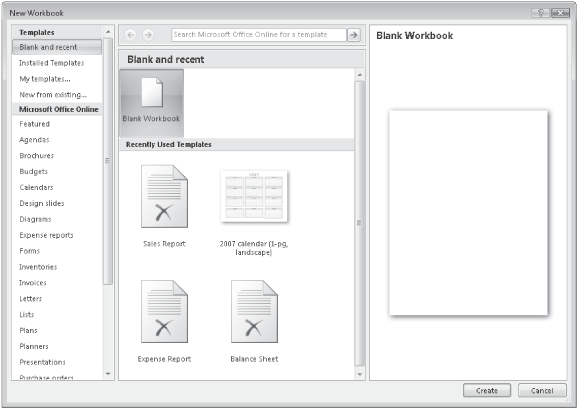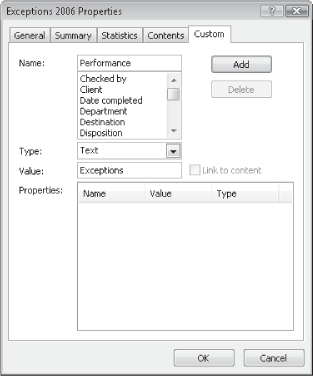Every time you want to gather and store data that isn't closely related to any of your other existing data, you should create a new workbook. The default new workbook in Excel 2007 has three worksheets, although you can add more worksheets or delete existing worksheets if you want. Creating a new workbook is a straightforward process—you just click the Microsoft Office Button, click New, and identify the type of workbook you want to create.
When you start Excel 2007, the program displays a new, blank workbook; you can begin to enter data in the worksheet's cells or open an existing workbook. In the exercises that follow, you'll work with some of the workbooks that have already been created for Consolidated Messenger. After you make any desired changes to a workbook, you should save the workbook to avoid losing your work.
When you save a file, you overwrite the previous copy of the file. If you have made changes that you want to save, but you want to keep a copy of the file as it was previously, you can use the Save As command to specify a name for the new file.
Tip
Readers frequently ask, "How often should I save my files?" It is good practice to save your changes every half hour or even every five minutes, but the best time to save a file is whenever you make a change that you would hate to have to make again.
You also can use the controls in the Save As dialog box to specify a different format for the new file and a different location in which to save the new version of the file. For example, Jenny Lysaker, the chief operating officer of Consolidated Messenger, might want to save an Office Excel file that tracks consulting expenses as an Office Excel 2003 file if she needs to share the file with a consulting firm that uses Office Excel 2003.
After you create a file, you can add additional information to make the file easier to find when you search for it using the Windows search facility. Each category of information, or property, stores specific information about your file. In Windows, you can search for files based on the file's author or title, or by keywords associated with the file. A file tracking the postal code destinations of all packages sent from a collection might have the keywords postal, destination, and origin associated with it.
To set values for your workbook's properties, click the Microsoft Office Button, point to Prepare, and click Properties to display the Document Properties panel on the user interface. The Standard version of the Document Properties panel has fields for the file's author, title, subject, keywords, category, and status, and any comments about the file. You can also create custom properties by clicking the Property Views and Options button, located just to the right of the Document Properties label, and then clicking Advanced Properties.
On the Custom tab of the advanced Properties dialog box, you can click one of the existing custom categories or create your own by typing a new property name in the Name field, clicking the Type arrow and selecting a data type (for example, Text, Date, Number, Yes/No), selecting or typing a value in the Value field, and then clicking Add. If you want to delete an existing custom property, move your mouse pointer down to the Properties list, click the property you want to get rid of, and click Delete. After you finish making your changes, click the OK button. To hide the Document Properties panel on the user interface, click the Close button in the upper-right corner of the panel.
In this exercise, you will create a new workbook, save the workbook under a new name, assign values to the workbook's standard properties, and create a custom property.
Note
USE the Exception Summary workbook. This practice file is located in the DocumentsMicrosoft Press2007OfficeSBS_HomeStudentExcelCreating folder.
BE SURE TO start Excel 2007 before beginning these exercises.
OPEN the Exception Summary workbook.
 Click the Microsoft Office Button, and then click Close.
Click the Microsoft Office Button, and then click Close.The Exception Summary workbook closes.
Click the Microsoft Office Button, and then click New.
Click Blank Workbook, and then click Create.
A new, blank workbook appears.
Use the navigation controls to display the DocumentsMicrosoft Press2007OfficeSBS_HomeStudentExcelCreating folder. In the File name field, type Exceptions 2006.
Click the Save button.
Excel 2007 saves your work, and the Save As dialog box closes.
Click the Microsoft Office Button, click Prepare, and then click Properties.
In the Keywords field, type exceptions, regional, percentage.
In the Category field, type performance.
Click the Property View and Options button, and then click Advanced Properties.
The Exceptions 2006 Properties dialog box opens.
Click Custom.
The Custom tab appears.
In the Name field, type Performance.
In the Value field, type Exceptions.
Click the Add button, and then click OK.
The Exceptions 2006 Properties dialog box closes.
 On the Quick Access Toolbar, click the Save button to save your work.
On the Quick Access Toolbar, click the Save button to save your work.




